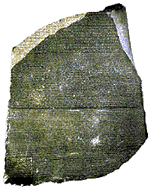Rosetta Stone
| |
Egyptology Articles
Herbs and Aroma
Alternative
Medicine
Aroma Therapy
|
|
The
Rosetta stone is very famous for it provided the key to solve the ancient
Egyptian language. The Rosetta Stone was carved in 196 B.C. It
was discovered by the French soldiers
who came with Napoleon. The Frenchman Jean François Champollion is the
one who cracked the code of the stone. The
discovery of the stone of rosette later called Rosetta stone is an
interesting story.
The
stone was discovered by the French troops in Napoleon's military
expedition, in 1799 in Lower Egypt, when they were digging the foundations
of an addition to a fort near the town of el-Rashid (Rosetta), in the Nile
Delta.
It
was discovered near the town of Rosetta (now
Rashid), located in the Nile Delta about 40 miles northeast of Alexandria, by
a Frenchman, Pierre Bouchard, on 15 July 1799. Captain Bouchard, an engineer
officer in Napoleon's expedition to Egypt, was supervising the reconstruction
of an old fort, as part of the preparations for defending the French from
attacks by British and Turkish forces in the area. The Rosetta Stone came to
light during the demolition of a wall in the fort. Captain Bouchard saw that
the polished black basalt stone contained three sections of different types of
writing, and recognized its significance immediately. He sent the stone to
Cairo, to the scholars who also accompanied the French expedition to Egypt.
In 1801, after two years of warding off attacks by the British, and
after their defeat at Abuquir Bay, the French forces in Egypt surrendered.
Under the terms of the Treaty of Capitulation, all antiquities in the
possession of the French, including the Rosetta Stone, were ceded to the
British. |
 |
The stone is a compact basalt slab (114x72x28 cm) that was found in
July 1799 in the small Egyptian village Rosette (Raschid), which is located in
the western delta of the Nile. The stone contained words in three types of
writing: Egyptian hieroglyphs, Demotic, which is a shorthand version of
Egyptian hieroglyphic writing, and Greek. By translating the Greek section,
scholars were able to learn what the hieroglyphs meant. This enabled them to
translate inscriptions inside the Egyptian temples.
The
inscription on the stone was a decree passed by a general council of priests
which assembled at Memphis on the first anniversary of the coronation of
Ptolemy V Epiphanes, king of all Egypt. The text concerns the honours bestowed
on the king by temples of Egypt in return for services rendered by him to
Egypt both at home and abroad. Priestly privileges, especially those of an
economic nature, are listed in detail. Because the inscription appears in
three scripts, hieroglyphic, demotic, and Greek, scholars were able to
decipher the Egyptian hieroglyphic and demotic versions by comparing them with
the Greek version.
The
representation of a single text of the three mentioned script variants enabled
the French scholar Jean Francois Champollion (1790-1832) in 1822 to basically
decipher the hieroglyphs. Furthermore, with the aid of the Coptic language
(language of the Christian descendants of the ancient Egyptians), he succeeded
to realize the phonetic value of the hieroglyphs. This proved the fact that
hieroglyphs do not have only symbolic meaning, but that they also served as a
"spoken language".
Another
British physicist Thomas Young worked on the translation of the stone with the
French Egyptologist Jean François Champollion.
Thomas
Young, the English Physicist, was the first to prove that the elongated ovals
or cartouches in the hieroglyphic section of the stone contained a royal name
written phonetically, in this case that of Ptolemy. Jean François Champollion
went on to correct and enlarge Young's list of phonetic hieroglyphs and lay
the foundations of our knowledge of the ancient Egyptian language in a paper
which was read to the Académie des Inscriptions et Belles-Lettres in Paris in
1822.
It
was this discovery -- that the Egyptian hieroglyphic writing system used a
combination of ideograms, phonetic signs, and determinatives -- that provided
the breakthrough in the translation of hieroglyphic writing. And this ability
to read the ancient hieroglyphs in turn opened the door to the history of
ancient Egypt and gave birth to the new discipline of Egyptology.
| . |
|
 |
| . |
|
You may freely reprint this article
or place it on your website by
adding this statement: Courtesy of www.kingtutshop.com
|
_________________________________

